This post contains affiliate links.
Ancient civilizations make great games as they really have great illustrations and stimulate imagination.
These 5 board games tackle ancient history using well-designed game pieces and unique gameplay. “Valley of the Kings” tops the list because it covers Egypt’s ancient nobles and after-life preparation rituals while “Thebes” immerses players in an archaeological expedition in ancient cities.
Board Games That Teach History Comparison Table
Here’s a quick comparison table to guide you on player count and other features of each game.
| Game | Age | Players | For | Price | Rating |
|---|---|---|---|---|---|
| Ankh Gods of Egypt | 14+ | 2‑5 | Families | $$$$$ | ★★★★☆ |
| Mare Nostrum | 14+ | 3‑5 | Families | $$$$ | ★★★☆☆ |
| Mesopotamia | 10+ | 2‑4 | Families | $$$$ | ★★★☆☆ |
| Thebes | 10+ | 2-4 | Families, Teachers | $$$ | ★★★★★ |
| Valley of the Kings | 14+ | 1‑6 | Families, Teachers | $$$ | ★★★★★ |
Board Games that Teach Ancient History
Ankh Gods of Egypt (CMON)
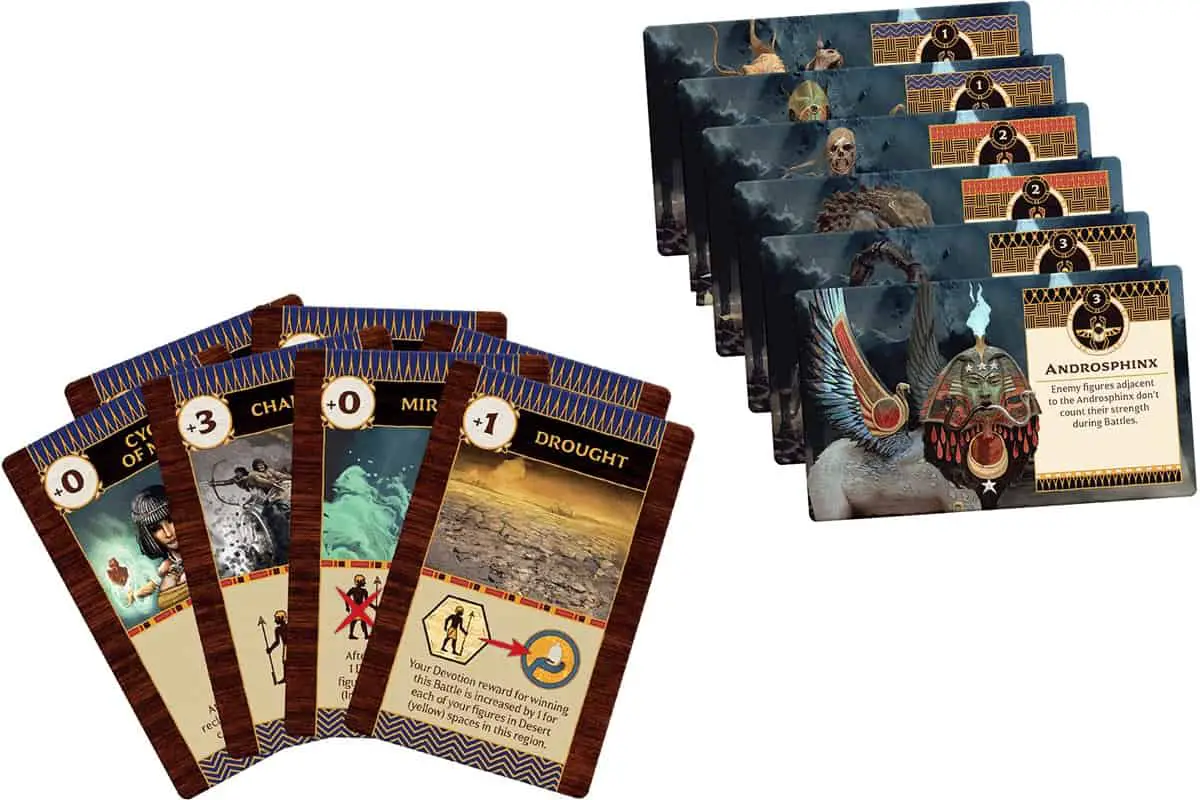
★★★★☆
Families| Age 14+ | 2-5 Players | Game Duration: 90 minutes| Designer: Eric M. Lang
In the Ankh Gods of Egypt, players assume the role of gods of Egypt, and they fight for supremacy.
players assume the role of gods of Egypt, and they fight for supremacy.
They compete for devotion points that can be collected by recruiting warriors, controlling obelisks, temples, and pyramids, and building followers. The player with the highest devotion points wins the game.
Young players will enjoy the huge gameboard, great miniatures, and the fascinating monsters and gods’ powers.
Illustrations and the text inscribed on the player boards and cards add educational value. For instance, Ankh means the key to life- a hieroglyph you’ll see on most chips and boards in the game.
The game has two gameplay modes: basic and advanced. It is commonly enjoyed as a two-player game though it can have up to 5 players.
At first, the Ankh Gods of Egypt might be overwhelming, but you can watch this video by Gameboygeek to skip the rulebook:
Mare Nostrum Empires (Publisher Services Inc)
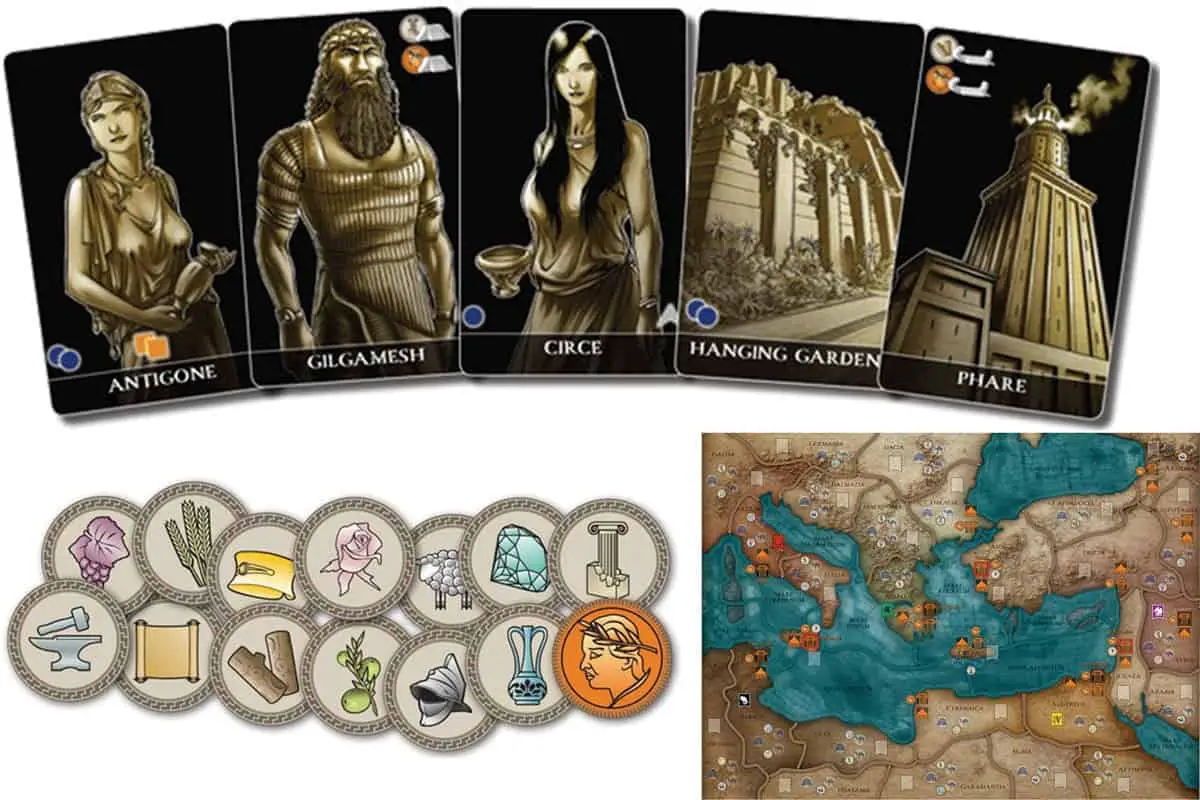
★★★☆☆
Families| Age 14+ | 3-5 Players | Game Duration: 90 minutes| Designer: Serge Laget
If your family is up for a strategy game that covers mythology, war, economic development, and ancient civilizations, Mare Nostrum Empires does them all.
does them all.
Mare Nostrum is a Latin phrase that means “Our Sea.” Romans used this phrase to refer to the Mediterranean Sea as they conquered new provinces and expanded the Roman empire.
This empire-building game consists of a gameboard, tiles, coins, counters, land and sea battle dice, mounted boards for leadership, heroes and wonders, and 5 different sets of color-coded markers and miniatures.
Each player represents one of the empires below:
- Babylon (purple)
- Carthage (Black)
- Egypt (yellow)
- Greece (green)
- Rome (red)
Each empire travels to different places on the gameboard to collect goods, recruit heroes for battles, and earn points for military, trade, culture and leadership tracks. The player with the highest points wins the game.
I recommend this strategy game because
- players will learn about ancient heroes, including Cleopatra, Caesar, Hammurabi, Pericles, Hannibal, and many more. The cards also contain monsters from Greek, Roman, and Eastern mythology.
- The game is easy to teach and play
I am giving this game three stars because it may turn competitive and mean.
Here is a great video that shows how to play Mare Nostrum Empires:
Mesopotamia: Cradle of Civilization (Phalanx Games)
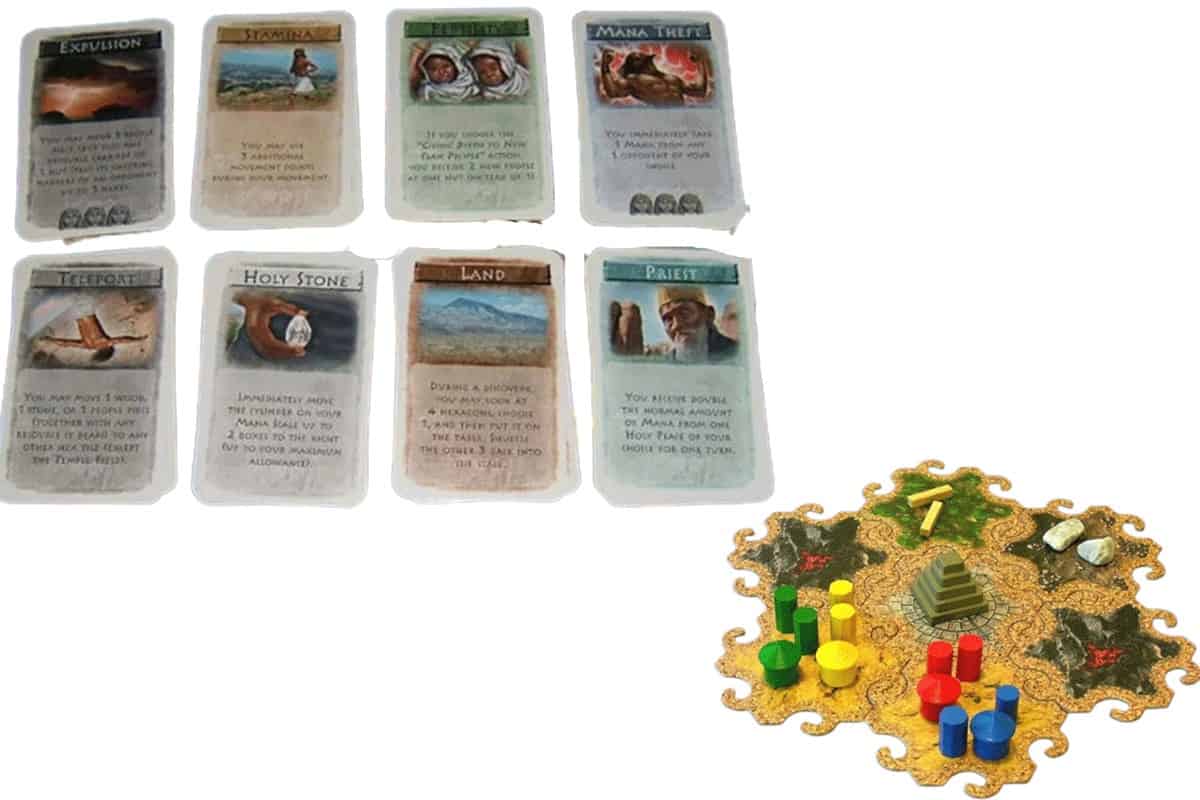
★★★☆☆
Families | Age: 10+ | 2-4 Players | Game Duration: 45 minutes| Author: Klaus Jurgen Wrede
In Mesopotamia , players race to bring 4 offerings to Ziggurat to obtain the highest reward from the god, Marduk. The Ziggurat is located at the center of the gameboard.
, players race to bring 4 offerings to Ziggurat to obtain the highest reward from the god, Marduk. The Ziggurat is located at the center of the gameboard.
However, delivering an offering called Mana is not easy. It can only be reserved by praying in the temple and players can only increase their workers if they produce huts.
Therefore, players strategize in constructing huts and temples on the gameboard. Otherwise, their opponents can steal their temples or move their huts away from the Ziggurat.
This game includes hexagon tiles, playing cards, mana scales, cylinders, beams, huts, markers, wood and stone resources, natives and a temple. It also comes with a quick start guide and a rulebook.
I recommend this game because it is easy to play, and players will learn how important Ziggurat offerings are to ancient Mesopotamians.
Mesopotamia is a Spiel des Jahres recommended game in 2006.
Thebes (Queen Games)
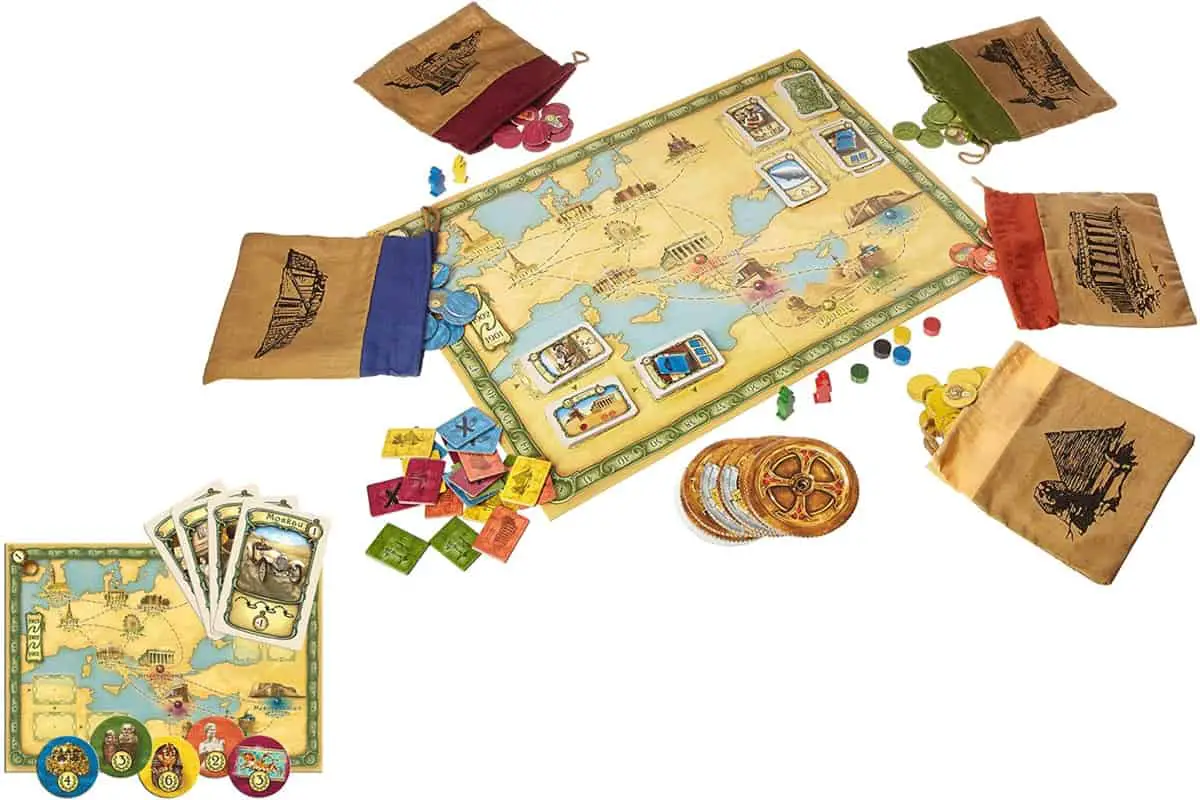
★★★★★
Families and Teachers | Age: 10+ | 2-4 Players | Game Duration: 60 minutes | Designer: Peter Prinz
If you would like to introduce archaeology to your kids, Thebes is the perfect game for it.
is the perfect game for it.
In this family exploration game, players pretend to be archaeologists who travel worldwide to acquire knowledge of ancient civilizations, dig artifacts and display them in exhibitions.
At the start of the game, each player will get excavation permits, an explorer figure, and a time stone of their chosen color.
Players move around the gameboard that has a unique time-tracker composed of 52 weeks where 1 week is equal to 1 space on the panel of the gameboard.
That means the longer the players spend time on a certain action on research cards, the greater number of tokens they could get from the excavation sites: Crete, Egypt, Greece, Palestine, and Mesopotamia.
Each excavation site has 13 valuable artifacts and 1 token for specialized and general knowledge. There are a total of 155 excavation tokens. Players dig artifacts by drawing these tokens from a cloth bag.
Players can buy equipment for excavation and acquire research cards in Berlin, London, Moscow, Paris, Rome, and Vienna.
The game’s goal is to collect victory points from cards and tokens, and the player with the greatest number of victory points wins the game.
I highly recommend Thebes because children will learn about ancient civilizations through an enjoyable simulation of an archaeological expedition.
Children aged 10 years old may need adult supervision to carry out the action on the research cards and calculate their movement on the time-tracker.
Check out the game instructions of Thebes in this official instructions video:
Valley of the Kings (Alderac Entertainment Group)
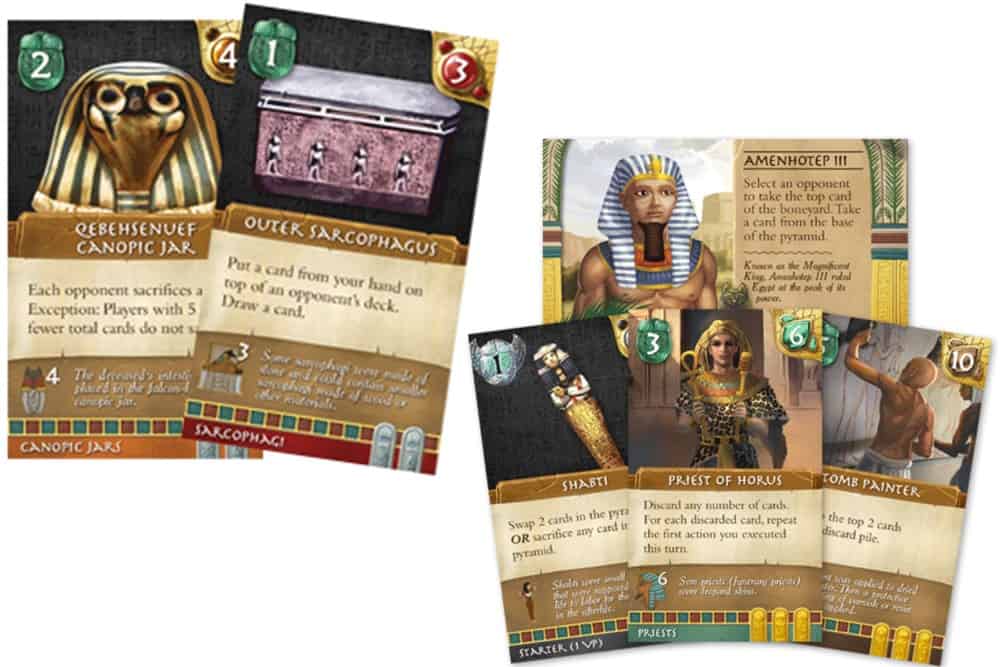
★★★★★
Families and Teachers| Age 14+ | 1-6 Players |Game Duration: 45-60 minutes| Designer: Tom Cleaver
Players become pharaohs who fill their tomb with treasures in the Valley of the Kings. The winner is the player with the most valuable artifacts at the end of the game.
The winner is the player with the most valuable artifacts at the end of the game.
The pharaohs in this game are Akhenaten, Amenhotep III, Cleopatra VII, Djoser, Hatshepsut, Khafre, Khufu, Ramesses II, Tutankhamun, and Thutmose III.
In this game, players strategize in buying, playing, and choosing cards to entomb. They keep an eye on the cards on the pyramids and the cards on their hands simultaneously.
I highly recommend this strategy game because:
- The cards are big but easy to use. They are excellent learning aids in the classroom because they contain explanations and clear images of the pharaohs, Egyptian gods, rituals, and the treasures that must be gathered for the afterlife.
This deck-building game uses 294 artifact cards, 6 reference cards, 10 pharaoh cards, 20 randomizer cards, 6 tomb tiles, 39 card dividers, and 350 Tarot-sized sleeves. It also contains a rule book and a player guide.
This game requires plenty of card shuffling, so some players may not be fond of this.
You can learn more about Valley of the Kings in this video by Tom Vasel:
Other Types of History Games
If you are interested in other history games, you might want to check my other posts:
- 6 History-themed War Games

- 14 American History Card Games and Flash Cards for Families and Schools

- 18 Card Games That Teach World History for Families and Schools

- 7 Art History Board Games for School and Home

- 20 Memory Games To Teach Art and Art History

Edudingo.com is a participant in the Amazon Services LLC Associates Program, an affiliate advertising program designed to provide a means for sites to earn advertising fees by advertising and linking to Amazon.com. We also participate in other affiliate programs which compensate us for referring traffic.

